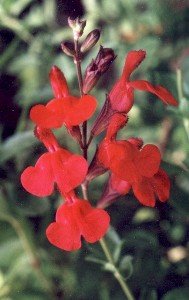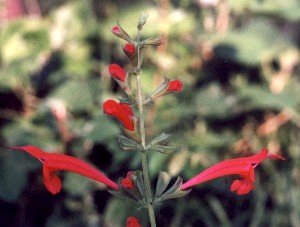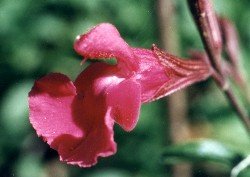Red Salvias
by Valerie (June 27, 2002)
Salvias are very popular garden flowers, and most are commonly called sage. We have numerous species, including four natives that all have red blossoms. There is a commonly available cultivated red salvia grown as an annual that often goes by names like red salvia, crimson salvia, and scarlet salvia. That species is Salvia splendens and is not included in this article. Other colored sages can be found at Blue Salvias and Other Salvias (pink and lavender).

These plants are all perennials but the most widespread species is the most tender. Tropical sage (Salvia coccinea) occurs all across the southern states, but does best in wet, warm climates. It is just a bit too dry and gets a little too cold for it to flourish for us. This plant has a lot of common names, including blood sage, scarlet sage, Texas sage, Indian fire, mejorana, red sage, and hummingbird sage. Tropical sage comes in several different color varieties, from white and peach, to pink and, of course, brilliant red. The way we obtained our plants was sort of indirect. Because we got them from my mother in Florida, I've often referred to them as Florida sage. Actually, the plant is more associated with Texas. Some of our tropical sage plants have died during hard winters, but they seem to suffer greatly during the hot, dry summers. A couple small plants keep sending up shoots every year, but they are not thriving.
A similar species, cedar sage (Salvia roemeriana) is another deciduous plant, but root hardy. It also takes the dry conditions very well. The name comes from its ability to thrive in the shade of juniper, or cedar, trees. Few plants grow at the base of the common junipers here, as the roots of the tree are very efficient at removing moisture from the surrounding soil. Cedar sage tends to grow between rocks, in gravelly soil, but doesn't do well if it is crowded by other plants. It is small, growing only about one foot tall. While it will bloom admirably in the shade, it does even better with adequate sun. The leaves are a bit more fuzzy than tropical sage and the shape of the blossoms is different. The color of the flowers is an amazingly brilliant red.
The most widely available red sage is a west Texas native, cherry sage (Salvia greggii). This plant is quite different than the previous two, in being more of a woody shrub. The leaves are small, smooth and rather thick. Although it freezes back, it often doesn't do so all the way to the ground and must be pruned to keep from becoming too sprawling. Cherry sage is also called autumn sage, but it blooms all summer long. Very drought tolerant, this salvia does best with full sun. In the shade, the plant becomes long-stemmed with few flowers. Cherry sage comes in shades from white through bright red, with a sort of pinkish red being quite common.
Big red sage (Salvia penstemonoides) is a fascinating Texas native, with extremely limited range in the wild. At one time it was thought to be extinct, but it was then rediscovered in its native habitat. It is now being used more as a landscape plant and is one of the easiest salvias to grow from seed. The species name comes from the large rosette of leaves that forms at the base of the plant, which looks much like penstemon. Also called giant sage, the reason for the name becomes obvious when a fully mature specimen is seen. This sage gets to be about five feet tall and the blossoms themselves are twice as big as most other red sages. The actual hue of the blossoms is a bit more subdued than other species, being a bit darker and with a maroon tint. I started several plants from seed, but lost some when they became overgrown with other plants. The survivors are still not yet blossoming, but are looking very healthy in their second summer. As with many perennials, it takes some time, but eventually the plants will come to dominate their area of the gardens. |


